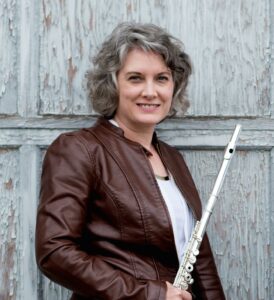Flute – Solo/Duo
Solo Flute:
Sonata for Flute and Piano (7/3/2019) – 15’00”. The work is in four movements. The opening Allegro begins boldly with repeated notes from the flute and strong accents. The stately Adagio has a simple, ternary form above a platform of steady eighth-notes. The Cadenza that follows relies on diminished chords to heighten both its tension and melancholy. The concluding Con Moto follows immediately. MIDI recording.
Morning Musings (5/2/17) for solo flute – 6’00”. This piece uses five advanced techniques for the flute. They are flute pizzicato, tongue ram, aeolian sounds, pitch bend and key clicks. Despite the varied techniques, the piece is lyrical, like summer breezes in a quiet glade. MIDI recording.
Origami (5/22/16) for flute and piano – 5’31”. Musical elements in this piece keep folding over upon themselves; hence, the title. There are five sections in the work following roughly an ABABA form. The piece is characterized by clean, sparse textures reminiscent of a Japanese garden. MIDI recording.
Abruption (5/14/16) for solo flute – 5’00”. The title implies the sudden breaking away of a part of the whole. There are sudden changes in articulation, dynamics, rhythms and pitch ranges that might imply breaking away, but it was my intention to integrate these into a cohesive unit. The piece is stark, challenging the audience to contemplate life’s sudden changes. MIDI recording.
Three Semi-Tropical Etudes (8/21/14) for flute and piano – 10’00”. The Three Semi-Tropical Etudes are etudes in the loosest sense. They are so-named because two of them require a very relaxed performance style, and all three have both tricky internal rhythms and a rich melodic flow. MIDI recording.
Three Semi-Tropical Etudes was premiered by Rebecca Jeffreys and Molly Lozeau at Southern New Hampshire University in 2019. 
Flute Duo
Flute Flights (9/6/13) for two flutes – 5’40”. “Flute Flights” is an offbeat dance. You will find it tonal and folksy. And it has short phrases in both major and minor. The first melody is in groups of five and is very fast. Then you will hear a second melody played on top of the first. It is interrupted by exclamations in groups of four, but it returns in five. After that there are some variations that lead to a brief, slower section in triple meter. The slow section settles in minor. When the fast tempo returns, you will hear the first melody is still in minor. And as the piece ends you will hear both flutes playing the offbeat dance, one in major and one in minor, a third lower. But, just to keep things on a positive note, the major version wins out.

Beth Ratay’s Live performance: https://www.youtube.com/watch?v=E11RnJvyw4s